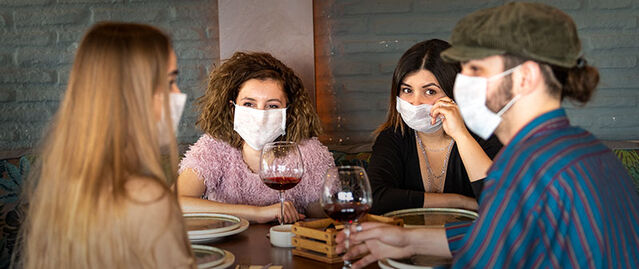Anxiety
How to Cope With “Re-Entry Anxiety”
Managing the not-so-normal post lockdown world.
Posted August 10, 2020 Reviewed by Lybi Ma

Many of us couldn’t wait until the lockdown was over. We wanted the claustrophobia lifted and the rhythm of our daily life back, not artificially set by our clock or television programs.
Here we are, certain parts of the world are opening up again, and many of us are feeling as much anxiety about that as we did when we were quarantined or sheltering in place. In fact, many of us are feeling even more anxious. Here are some reasons why:
When we were sheltering from the viral storm, we felt a sense of control. As long as we weren’t in contact with anyone or anything transmitting the virus, we felt confined, yet safe. Now we are no longer in complete control over our exposure and risk and, as I often say, when a sense of control goes down, stress goes up.
Next, our brains helped us adjust to the quarantine extensions by interpreting them as lifesaving. Now, we are trying to convince our brains that it’s okay to leave home, go to work, and socialize within guidelines again, although the virus is not gone. We’re hypervigilant and our brains have a lot to process to understand this new perspective – they are trying to let us act in a way that it is both lifesaving and life-affirming.
The news and social media are still filled with warnings, dire predictions, and frightening statistics. When we start and end our day with the news, we become anxious about the day ahead and worry about what exposure we might have had yesterday.
Additionally, social pressure to socialize can add anxiety. If our friends and family are out and about, they often want us to be as well, despite our special vulnerabilities or comfort levels. This helps justify their choices and enlarges their group. But, if we are not ready or comfortable going to restaurants or dinners, we may feel judged, labeled as phobic, or even ostracized. If we give in, we then have the anxiety of waiting and watching for COVID symptoms and may worry about putting our vulnerable loved ones in danger.
Seeing people walking around in masks can also make us want to stay home. Masks remind us that there is potential danger all around us, that the danger is invisible, and that life is not back to “normal.” Masks also make friends look unfamiliar and hide their smiles. However, seeing people wear masks as acts of kindness for others who may be vulnerable because of age or health problems usually quiets those reactions as does the mantra, “this too shall pass.”
What can we do to ease re-entry anxiety? Here are five tips to help:
- Try to separate caution and fear. If you are still isolated because of fear and not by choice, learn more about the virus, how it’s transmitted, and how you can protect yourself. It will be less mysterious and more personally manageable using tactics in public like social distancing, wearing a mask, and handwashing.
- Restrict your media exposure on COVID-19. The virus coverage is constant, limit your consumption to once in the morning and once in the evening and you will be up to date without being overwhelmed. Also, make sure all the online information you pass on is from reliable medical sources only. I use the CDC and hospital/university sites to double-check every COVID-related text and email I receive that is filled with advice or information from well-meaning friends and have rarely found any to be accurate.
- Gather encouraging and interesting information about the medical advances and information related to this virus. Things are changing rapidly and keeping up with the positive trajectory can cause you to feel curious instead of cursed. It will help counter and balance the frightening headlines and help you look at the pandemic with some distance and objectivity. This is not the first pandemic, nor is it the last.
- Start small. After doing all of this, then you are better prepared to start taking small, comfortable, and safe steps to re-enter the outside world. Some therapists call this exposure therapy because you’re exposing manageable levels of anxiety into your daily life. You might meet one friend you trust for a walk, six feet apart, for ten minutes. Do not let yourself end it early or give in to unrealistic anxiety. It may take a few ten-minute walks before you are ready for a longer walk or meeting more than one friend at a time. Again, if you are wearing masks and socially distanced, complete the next step and then set a new goal. If you give in to panic, your anxiety will drop when you “run”, or leave the plan, but now you’ve just rewarded yourself for withdrawing and made it harder to move forward again. Count your steps as you walk, or hum a childhood tune, and you will distract yourself from scary scenarios and bring yourself back to your short walk, to the present.
- Try to find a re-entry buddy. Like during exercise and weight loss, buddies increase your chances of success. You can push each other along, sympathize with each other, and even compete. If you are having no problem with re-entry but you know someone who is, offer to be their buddy. You might be helping to change their life, at least for now.
While all of these steps are helpful, as you re-enter make sure not to forget all you have learned about your resiliency and patience during the quarantine. Take all those lessons with you as you carefully re-enter life outside your home in these ways that will help keep anxiety to a minimum.


